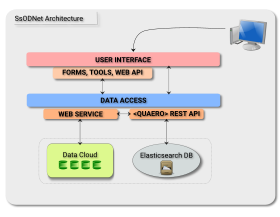 | THE IMCCE VIRTUAL OBSERVATORY |  |
 Presentation
PresentationSsODNet is developped by the VO-IMCCE team, in the frameworks of the International Virtual Observatory Alliance. It was thought to meet the requirements of the planetary scientist community, in particular to provide an easy access to data which are used daily. The core of SsODNet is a name resolver, which provides basic information for all solar system and extrasolar bodies: planets, satellites, asteroids, comets, spacecrafts and spacejunk orbiting the Earth, and exoplanets. SsODNet is also a data aggregator, thought to allow planetary scientists to share with each other their planetary data collections and services.
 Scientific issues
Scientific issuesThe resources which are available through SsODNet are composed of heterogeneous dataset of astronomical products shared by planetary scientists. SsODNet just acts as a hub which ensure the connection and the interoperability of the data (i.e. no transformation or conversion process).
 Technical issues
Technical issues
The figure herein enlightens the global architecture of SsODNet, which is composed of three layers: a user interface, a data access layer, and a cloud of data.
The user interface acts as a client of the service. It gathers the parameters, composes the user's request, and posts the request to the end points of SsODNet. A simple manner to do this is to use a data transfert program, such as curl or wget, and to send HTTP requests to the Web API (recommended to normal users), or directly to the Web service or the REST APIs (recommended to developers). A personal Web interface can easily be developed to manage the requests and display the results. Feel free to make your own! or just use our Web form.
The data are accessed through two APIs:
The data cloud refers to all the data which are collected and, for some of them, stored into the SsODNet databases, powered by Elasticsearch and MariaDB database engines. The main sources of data exploited by SsODNet are the following:
 User support
User supportThe information regarding requests sent to SsODNet is stored in a dedicated database. No personal information is stored, except the IP address of the client, which is employed to make statistics on the geographical localization of the SsODNet users. The SsODNet logs are never disseminated nor sent on request. You can access to the public logs by using the following URL:
If you are confronted with a bug, or if you would like to request improvements or special needs, please use the IMCCE Mantis Bug Tracker (quick access: use the Report issue menu in the portal menubar).
 How to cite SsODNet
How to cite SsODNet